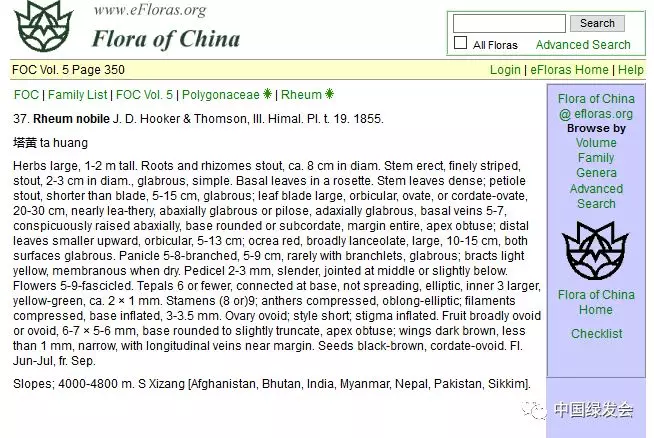Last week, volunteers from the China Biodiversity Conservation and Green Development Foundation (CBCGDF) reported on a Shangri-La man who had ostentatiously destroyed rare plants. Later, the man took the initiative to explain the situation to Shangri-la Forest Public Security Bureau of Diqing Prefecture, Yunnan Province. However, the punishment he received was only the oral education, because "Rheum nobile" was not a protected plant, and there was no legislative basis for punishment.
A report on Yunnan.CN introduced the process of the incident and its handling: on July 28th, under the pressure of internet public opinion, the video party Mr. Lurong took the initiative to explain the situation to the Shangri-La Forest Public Security Bureau of Diqing Prefecture. After the incident, the leaders of Shangri-la Forestry Public Security Bureau attached great importance to it, and immediately arranged for the police brigade to conduct an investigation. According to the video party Mr. Lurong, he did send a video of tearing "Rheum nobile" by hand on July 26th. On the way to Daocheng County (Ganzi Prefecture, Sichuan Province), when the party, his aunt and his brother-in-law drove past the 4900-meter mound of Laoxiangdu Road, his aunt saw a "Rheum nobile" (Tibetan name: "Gongpi") growing on the hill, and she said that she wants to eat it. Then the party went to pick "Rheum nobile" and asked his brother-in-law to record the video, and the video was uploaded to TikTok short video app. Finally, three of them shared "Rheum nobile" plant together. The plant residues extracted by the police on the spot were identified by the Forestry Judicial Appraisal Center of Shangri-La (Diqing Prefecture, Yunnan Province), as "Rheum nobile", which is not a nationally protected plant. According to the relevant laws and regulations of plant protection in China and the appraisal report of Shangri-La Forestry Forestry Judicial Appraisal Center, the behavior of a Mr. Lurong does not constitute an illegal act. Therefore, the result of this incident is only an oral education.
Rheum nobile, the Sikkim rhubarb or noble rhubarb or ??????, is an alpine plant, also known in Tibetan as Gongpi, perennial tall herbaceous Polygonaceae. Their rhizomes and roots are long and strong, usually distributed in the foothills of the Himalayas in Tibet and northwest Yunnan, China, and on the mountain drift-stone beaches and wet grasslands at altitudes of 4000-4800 meters. They are the most powerful support for soil and water conservation in the plateau. According to experts from Kunming Institute of Chinese Academy of Sciences, the flowering period of this plant is 15 to 45 years, and only once in a lifetime. It takes 15 to 45 years of nutrient accumulation for each plant to blossom, and after tens of thousands of seeds, the plant will die.
The first description of "Rheum nobile" by westerners can be traced back to the words written by Joseph Dalton Hooker and Thomas Thomson in 1855: "‘Rheum nobile' is undoubtedly the most remarkable of many fine alpine plants found in Xijin. Although it has acid juice like many other rhubarb stem plants, it looks distinctly different. The first time I saw it was a mile away, on the black cliff of the Laqin Valley at an altitude of 4,300 meters.
This "Rheum nobile" grew on the plateau for decades, and finally waited for the most glorious moment of life, but it was too late to spread its seeds, it tragically died because of a tourist. If it hadn't been for the show-off video of this tourist, the volunteers of the CBCGDF would not have paid attention to this and spoken for the plant. In fact, with the increasing destruction of nature by human beings, the sixth mass extinction has been brought about.
Recently, the author had a meeting with an expert from the Institute of Botany of the Chinese Academy of Sciences, he raised a question that: compared with the disappearance of wildlife, the situation of many endangered and rare wild plants is more worrying. They are often found to be on the verge of extinction, but already in an irreversible extent.
The incident of "tearing ‘Rheum nobile'" reflects several deep-seated questions worth pondering:
How to ensure that the biodiversity of endangered plants is protected legally?
According to the 2018 China Eco-environment Bulletin, there are 98,317 known species and subspecific units in China, of which 44,510 species belong to the botanical kingdom. In June, the author participated in a seminar on Biodiversity after 2020, at which an authoritative expert in the industry expressed great concern: there are tens of thousands of plants in China, but only 300 species were listed on the protection list (1999 plant protection list). This has made it very difficult to enforce the law in cases involving plant protection in China for many years.
Vice Premier Han Zheng pointed out at the meeting of the National Committee for Biodiversity Conservation of China on February 13th that the most stringent system and the most stringent rule of law should be used to promote biodiversity conservation and ensure that there are laws and regulations for biodiversity conservation. Previously, President Xi Jinping had pointed out that the protection of rare plants is an important part of the protection of the ecological environment. Firstly, the concept should respect science and implement responsibility. President Xi also asked that the system of ecological civilization should be improved, and the ecological environment should be protected by the strictest system and the strictest rule of law.
Top-level design is particularly important in "ensuring that there are laws and regulations for biodiversity conservation". As the United Nations Convention on Biological Diversity (CBD) will be held in China in 2020, and a new UN framework for biological diversity will be born in Yunnan Province, China, can "biodiversity protection" be included in China's constitution? Can China have a law on biodiversity protection?
2. How can the identification of "national plant protection" in China reflect the latest status of biodiversity?
In the UN Millennium Development Goals (2000-2015) signed by China, the only item 7B that has not been achieved is "to reduce biodiversity loss and significantly reduce the rate of biodiversity decline by 2010". As things stand now, it remains to be seen whether the 2030 agenda for sustainable development can achieve the protection of biodiversity.
How can identification keep pace with the rapid loss of biodiversity? Class I and class II protected plants in China are determined by the "List of National Key Protected Wild Plants of China” and are the specific objects of protection and management in the "Regulations of the People's Republic of China on Wild Plants Protection". On August 4th, 1999, the "List of National Key Protected Wild Plants of China" (1st batch) was officially approved and published by the State Council of People's Republic of China. As we all know, the past 20 years have witnessed rapid economic and social development in China, as well as vigorous consumption of natural resources. So, is today's state of biodiversity up to date by the standards of the last 20 years?
3. How can Tibetan medicine achieve sustainable development?
According to the propaganda department of the Shangri-la Municipal Party Committee, "Rheum nobile" has long been used as a Traditional Chinese Medicine (TCM) in plateau areas. Therefore, searching for the information of "Rheum nobile" on the internet is listed as a valuable Tibetan medicine. As mentioned earlier, it takes 15 to 45 years of nutritional accumulation for a "Rheum nobile" to bloom and go to seed. With more and more humans interfering with and using its habitat, the use of such large frequencies may not be sustainable —— and the species may be on its way to extinction in a matter of years. Do our generations want to use up all the natural resources of future generations? How can Tibetan medicine achieve sustainable development?
4. What ecological ethics should be observed in tourism?
Although the incident was not a tourist event, there was a lot of discussion about tourism and ecological ethics online before the man's identity was made clear. What ecological ethics should tourism follow?
The rapid loss of biodiversity is a major environmental challenge facing the world. According to the latest IPBES report, one million species are endangered, seriously threatening the future of all mankind. Earth has entered its sixth mass extinction, and this time it has been caused by humans —— our destruction of biodiversity and ecosystem services has become a threat to human well-being.
The plateau plant "Rheum nobile" has revealed the tip of the iceberg, reflecting the survival crisis and intractable difficulties faced by millions of endangered rare plants and other minority plants in China. We speak for the voiceless, and we are deeply concerned about the fate of this species. For the related follow-up of this case, the CBCGDF will continue to pay attention to and report.

(Photo source: Internet)

(Photo credit: Wikipedia / Bill Baker)

(Photo credit: Wikipedia)

(Photo credit: efloras.org)

Original Chinese article:
http://www.cbcgdf.org/NewsShow/4854/9434.html
By / Xue Tongtong
